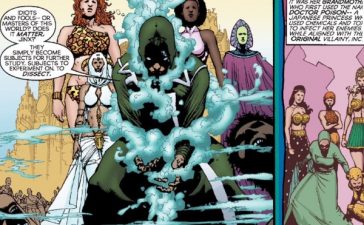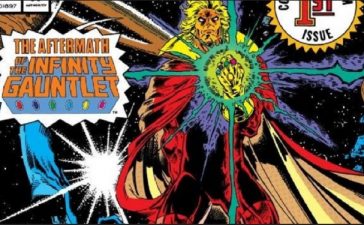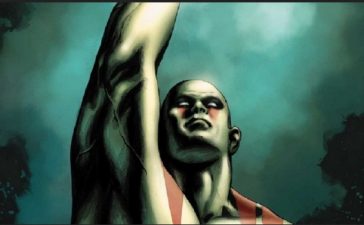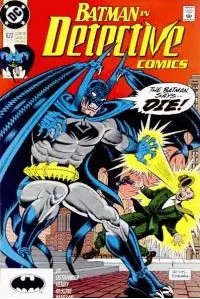
In my previous two Bat-articles, I have discussed specific periods in the evolution of The Caped Crusader. Two weeks ago, I covered the earliest Batman stories, while last Monday I looked at how thirty years later, Dennis O’Neil and Neal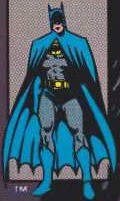 Adams redefined The Dark Knight. Today, I would like to move forward in time again to 1990 and examine an assortment of Batman and Detective Comics issues which roughly covers a year. With this time jump, I shall be entering the period where I was buying Batman comics off the racks as new releases. Some of these stories I read at the time, some I skipped over, though I haven’t looked at any of them for a couple decades.
Adams redefined The Dark Knight. Today, I would like to move forward in time again to 1990 and examine an assortment of Batman and Detective Comics issues which roughly covers a year. With this time jump, I shall be entering the period where I was buying Batman comics off the racks as new releases. Some of these stories I read at the time, some I skipped over, though I haven’t looked at any of them for a couple decades.
I am also going to alter my format a little, and break my piece into capsule discussions of the different storylines. There is a fair bit of material here by a variety of creators, and this strikes me as the best way to give everyone their fair share.
So, here we go:
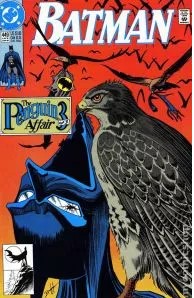
What better way to start than with a crossover, right? This three-part story, “The Penguin Affair”, was co-written by Marv Wolfman and Alan Grant, who at the time were regular writers on Batman and Detective Comics respectively. It introduced into Batman’s world a scientifically brilliant, mute hunchback by the name of Harold. Harold was originally created by O’Neil for his Question series, but his use in the Bat-titles would make him a fan favorite. Here he is tricked by The Penguin into designing technology that allows Penguin to manipulate flocks of birds into crippling Gotham. Honestly, The Penguin has never been a favorite of mine, but I really enjoyed how Wolfman and Grant write him in this story. They minimize the clownish aspects of the character, and bring to fore his scheming intellect. This may be the best Penguin tale I have read. Also, having Jim Aparo, Norm Breyfogle and M.D. Bright each illustrate a chapter does not hurt.
Finally, there is an interesting scene where Bruce tries to calm down the still-in-training-not-yet-Robin Tim Drake. Tim wants to know why he is hanging around the Batcave playing chess while The Penguin is terrorizing the city. “Downtime, Tim,” Bruce answers, “There’s little time for creative thinking when you’re constantly reacting to events . . .” It would be nice if we could see this more relaxed side of Bruce a bit more often. (Yes, he sits too).
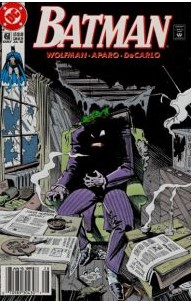
Discussions of Alan Moore’s possible origin for the Joker often center on how much, if anything, we should know about the character’s background. The general consensus, with which I agree, is that Moore struck a delicate balance by leaving up to interpretation how much of the Joker’s memories were “true” and how much are simply delusions masquerading as self-justification. These two issues show what happens when an author (in this case Wolfman) decides to more or less establish those events as known facts. A Joker impostor is loose in Gotham. During the course of the story we learn that not only does Batman know how the Joker became who he is, but that information is sitting in the files of Arkham Asylum for anyone who can their bribe their way into a doctor’s office. The other false note is that the true Joker is holed up somewhere quivering in self-doubt. It seems that following his near death at the end of Death in the Family, he is scared of resuming his former criminal career. At one point, he pulls out that old red hood to try and regain his confidence. As you might imagine, none of this works, which is a shame. This was the first time Batman confronted the Joker since Jason Todd’s death, and the first time Gordon had since The Killing Joke. Watching them sort through their fears is interesting, though not enough to save the story.
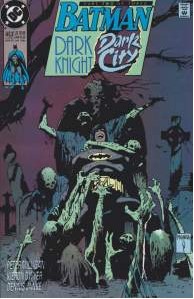
This is the moment where DC tried to darken The Riddler with mixed results. This three-part tale, “Dark Knight, Dark City”, was written by Peter Milligan. The Riddler is doing his usual thing of committing crimes and leaving behind riddles for the next one. Only this time, his actions are much more gruesome, involving hangings, projectiles of blood, kidnapped newborns and animated corpses. Eventually, the reader learns that The Riddler has been possessed by some ancient demon which is putting Batman through some complex rite of black magic. This part of the story does not quite hold together, and nor is this psychotic version of The Riddler overly appealing. It smacks too much of catering to the fads of the moment.
What is intriguing is how Milligan ties the demon into the history of Gotham itself. Summoned, then imprisoned beneath what in the 18th Century was outlying farmland, the demon’s presence seeps into the fabric of the city itself, influencing its development. The demon, named Barbathos, identifies itself with Gotham, implying that it created the environment which caused the death of Bruce’s parents. These supernatural themes should sound familiar to readers of Grant Morrison’s Batman. Some of these concepts would reappear in Morrison’s own history of Gotham City, including a founding demon with a very similar name: Barbatos.
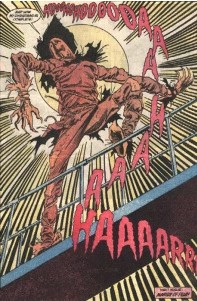
Grant and Breyfogle begin their run on Batman with this tale of the Scarecrow. The Scarecrow is infecting citizens with a new toxin, causing ordinary people to morph into homicidal maniacs. Along the way, Grant speculates on the importance of masks, and the power of anonymity. Grant writes a menacing Scarecrow, while Breyfogle’s expressive style is a perfect fit for the character. It’s a terrific Scarecrow tale.
However, what lends these three issues historical importance is that they are where Tim Drake’s long apprenticeship finally ends. Disobeying Batman’s orders, Tim leaves the Cave in order to rescue Batman. Afterwards, Tim is rewarded with a newly designed Robin costume. I remember reading this issue when it came out, and all these years later it is still a striking moment. (I’ll freely confess that Drake’s Robin costume has always been my favorite). Tim Drake’s long, popular career as Robin truly begins here.

OK, I remembered this being a weird one, and, yep, it still is. The first issue opens with a demon in Hell (heavily implied to be Lucifer himself) pleading repentance, begging for a way to make amends. Heaven grants that if he might find a human to serve as his avatar then he may walk upon the Earth once more. He accepts this challenge, binding himself to a world-weary “adventurer” by the name of Simon Petrarch. Together they become the supernatural spirit of vengeance known as Batman.
Still with me, right? Well, these scenes are part of a comic book imaging what Gotham’s protector might be like. Writer John Ostrander intercuts scenes from this fictional comic book with the true Batman investigating a serial killer inspired by said comic books. (Mike McKone handles the “real” sequences, while Flint Henry does the “fake” ones). It’s all a bit odd, but a fascinating story all the same. Ostrander uses this fictional Batman not only to riff on comic trends of the moment, but also the archetypes of Batman’s world. Robin is refashioned as Batman’s literal guardian angel, while the Joker is portrayed as the force of pure demonic evil we always considered him to be. Ostrander would soon go on to further explore such themes of morality and spirituality when The Spectre relaunched in 1992.
In addition to some highly imaginative art by Henry, the great covers for this story are by Golden Age Batman artist Dick Sprang.
With Grant and Breyfogle on Batman, Wolfman and Aparo take over Detective Comics. These are two stand-alone tales in which Batman takes on a pair of pretty forgettable foes (Abattoir & Electrocutioner). Honestly, outside of Aparo’s art and following the ongoing subplots, there is not much in these issues to recommend.
Another pair of stand-alones, though, in this case Grant crafts a better story. In 458, Grant returns to Harold, who has been living in an abandoned building since being cast aside by The Penguin. Instead of some disposable villain of the month, Grant focuses instead on Batman rescuing Harold from a mob wrongly convinced of Harold’s ill intentions. The result of this lesson in tolerance will be a new ally for The Dark Knight.
What is truly the focus of these two issues, however, is the reintroduction of Sarah Essen into Jim Gordon’s life. Lately, Gordon had been doing a lot of brooding over whether he made the right choices in life, if instead of being a cop, he could have taken the path of the Batman. These two issues contain some very nice character work with Gordon as his reunion with Essen revives his spirits. The two make an immediately endearing couple, whose courtship is made more poignant by knowing now the tragic fate waiting for Sarah at the end of the decade. Of more immediate concern, though, is the heart attack Gordon suffers at the end of #459 . . .
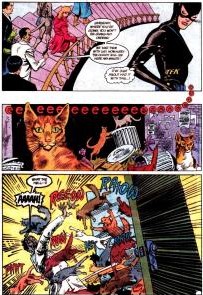
Batman is investigating a human trafficking operation, but the real focus here is on three women: Catwoman, Sarah Essen and Vicki Vale. Vicki Vale had been playing a larger role in the Bat-titles ever since her use in the first Tim Burton film. She is a much more compelling character in the comics, displaying a confidence and resourcefulness which was entirely lacking in the movie. While Batman plays his part, it is the trio of ladies who are ultimately responsible for defeating the traffickers. (An avalanche of streets cats play their part as well). A solid, enjoyable story. Also, Breyfogle draws a fantastic Catwoman.
For this anniversary issue, DC chose to examine The Dark Knight through the shifting context of time. First they reprinted the original Batman tale from Detective Comics #27, “The Case of the Chemical Syndicate.” This is followed by a reprint from 1969. In celebration of the 30th Anniversary of The Caped Crusader, Editor Julius Schwartz had commissioned a retelling of “The Chemical Syndicate” from Mike Friedrich and Bob Brown. In this take, the story focused on issues of presumed guilt and false assumptions of character. Just as Robin is confronted with his own rush to judgment on a young, rebellious youth, the young man in question is forced to reexamine his distrust of any authority figure. Also, you learn the Dick was a fan of Janis Joplin.
After these two reprints, DC offers up two new riffs on “The Chemical Syndicate.” The first of these by Wolfman and Aparo deviates most from the original framework, turning what had been a tale of corporate greed and murder into one of vengeance. Unfortunately in the process, Wolfman felt it was necessary to create another unremarkable adversary by the name of Pesticyde. This poorly designed character undercuts what would have been a good tale of contrast between one woman’s deadly quest to avenge her father and Batman’s different methods.
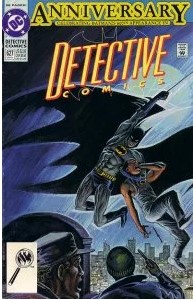
Grant & Breyfogle’s final tale follows the original plot more closely than either Friedrich or Wolfman, though, Grant does mirror Wolfman by including contemporary concerns for chemical pollution. (In the 1960s retelling it is the military industrial complex which has the young heir up in arms). Batman is a much more brutal force than Grant typically portrays him. I assume it is a nod to the tone of the original, though it does not sync well. Repeating Batman’s dispassionate “A fitting ending for his kind” line strikes a particularly false note. It is a disappointing outing from Grant, who is usually much more reliable. I did appreciate how Breyfogle, for one panel, reverted Batman’s cowl to its original diagonal ears.
All in all, I enjoyed revisiting this period of Batman, and would like to continue with it. I especially liked the Grant/Breyfogle contributions. Further reading, though, will involve tracking down more individual issues. For some reason, this period remains woefully neglected by DC. The fact that none of Breyfogle’s Bat-work, aside from what he did for “Knightfall,” has been collected is a glaring oversight by DC. He is one of the great Bat-artists, who deserves the same treatment Jim Aparo, Gene Colan and others have gotten before him. Good thing I enjoy digging through long boxes, as I suspect that I’ll be spending a fair amount of time sorting through the “B”s at my next convention.





